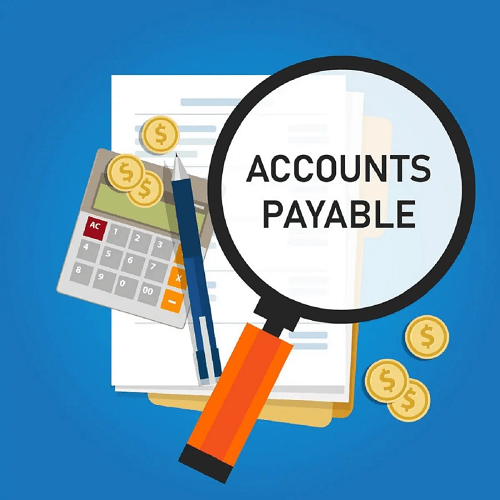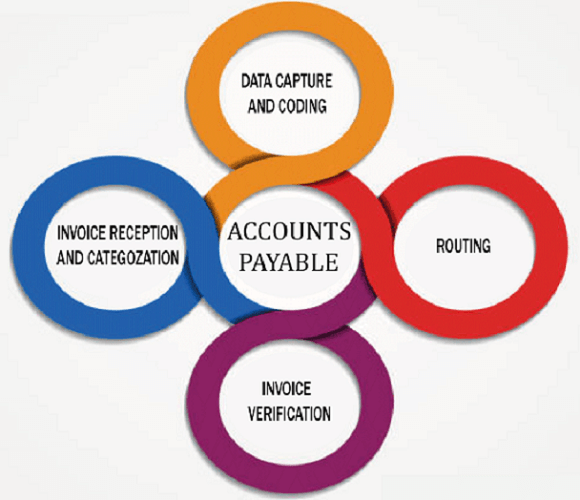Understanding Accounts Payable (AP) With Examples and How to Record APUnderstanding Accounts PayableThe phrase "Accounts Payable" (AP), often referred to as "payables", is used to refer to a company's present, short-term obligations to its creditors or suppliers. A company's balance statement shows its payables as a current liability. Another less common usage of the term "AP" refers to the business division or department in charge of making payments due by the firm to suppliers and other creditors. 
Accounts receivable and payable are comparable. The current liabilities portion of a company's balance sheet will display the entire amount of its accounts due at a certain time. Accounts payable liabilities must be settled within a certain time frame to avoid listing as default. The word "AP" refers to short-term supplier payments at the corporate level. The payable is simply a short-term IOU (I Owe You) agreement from one business to another business or organization. As a result of the transaction, the other party would raise its accounts receivable by an equal amount. A considerable quantity of AP appears on a company's balance sheet. If the AP is higher than the previous quarter, the company is using credit instead of cash to pay for more goods and services. If a corporation pays its obligations from the previous quarter more swiftly than it is obtaining new items on credit, its accounts payable (AP) will decrease. Controlling a company's cash flow depends on managing its accounts payable. The top component of the cash flow statement, or the cash flow from operational activities, shows the net change in AP from the preceding period when the indirect method is used to create the cash flow statement. Through AP, management may somewhat affect the company's cash flow. For instance, if management wants to increase cash reserves for a certain period, it may extend the time it takes for the business to settle all outstanding AP bills. When analyzing this option to pay later, it is important to consider the company's ongoing relationships with its suppliers. In most cases, paying invoices on time is a smart business move. Keeping Track of Account PayablesAll entries made to the general ledger must always have an offsetting debit and credit by double-entry accounting rules. When a bill or invoice is received, the accountant credits accounts payable to record accounts payable. The expenditure account for the product or service paid for with credit often receives the debit offset for this transaction. The debit might also be applied to an asset account if the purchased item was a capitalizable asset. Once the bill is paid, the accountant debits the account payable to lower the obligation amount. The cash account is given the offset credit, which reduces the cash balance. 
Consider a company receiving a $500 invoice for office supplies. When the invoice is received, the accounts payable department records a $500 credit in accounts payable and a $500 debit to office supplies expense. The corporation has recorded the purchase transaction even if cash has not yet been disbursed since the $500 debit to the office supplies expenditure flows through to the income statement at this time. This is consistent with accrual accounting, which recognizes expenditures as incurred rather than when money is exchanged. Following payment of the invoice by the business, the accountant records a $500 credit to the cash account and a $500 debit to accounts payable. A company may have several unpaid vendor invoices at any specific time. Accounts payable keeps track of any unpaid invoices to vendors. As a consequence, the total amount the company owes all of its suppliers and short-term lenders may be seen if someone checks the balance in accounts payable. The balance sheet shows this as the whole sum as well. For instance, if the firm mentioned above also received a $50 invoice for lawn care services, both entries in accounts payable would be totaled as $550 before the business settled those debts. Trade Payables vs. Accounts PayableAlthough "accounts payable" and "trade payables" are sometimes used interchangeably, they relate to somewhat comparable but distinct circumstances. Trade payables are the sums of money a firm owes its suppliers for items linked to its inventory, such as materials or business supplies. All of the short-term debt owed by the corporation is included in accounts payable. For instance, if a restaurant owes money to a firm that sells food or drinks, those products are included in its inventory and count toward its trade payables. Accounts payable covers debts owed to other businesses, including the one that cleans the uniforms used by the restaurant's personnel. These two subcategories are included in the larger accounts payable category, and many businesses refer to them as accounts payable. Comparing Accounts Payable and ReceivableAccounts payable (AP) and accounts receivable (AR) are fundamentally opposing concepts. Accounts payable represent amounts that a company owes to pay its suppliers, while accounts receivable represent amounts that a company is owed, often by customers. When two firms exchange goods or services on credit, one (the one buying) writes an entry in its books for accounts payable, while the other (the one selling) does so for accounts receivable. Additional Techniques to keep up with Account PayablesIt may be damaging to your relationship with a supplier to not pay an invoice because you lost or forgot about it. It is always good to clear all account payables timely. Follow these actions to ensure that you don't forget about clearing account payables: Eliminate PaperYou should always take advantage of the electronic invoicing and payment solutions that many suppliers provide. It is simpler to input electronic invoices into your accounting software, save them, and do searches on them. Sending electronic payments is simpler; they leave a paper trail and may be automated as well. If you ever receive a physical invoice, scan it and save it with the rest of your paperwork. You are less likely to forget a document if you keep all your accounts payable paperwork in one location. One of the best ways to clear accounts payable on time is to stop using paper. Schedule in your CalendarYou may put the due date for a supplier's invoice in your calendar right away and set a reminder accordingly. Additionally, you must ensure to set the reminder before the due date if you use a payment system that requires a few days to process. Have a Reserve of MoneyNot having the funds to pay an invoice is the greatest inducement to overlook it. If at all possible, make sure you have enough cash on hand to cover your accounts payable for a few months. Need assistance planning your next financial flow? It would be better if you contact account professionals. Implement Purchase OrdersSimilar to invoices, purchase orders are documents that a buyer sells to a seller. They provide you with legal protection in supplier disputes, assist you in avoiding audit issues, make life easier for your suppliers, and are the most useful tool a company can have for keeping track of significant and complicated transactions. When are Accounts Payable created?A payable is created whenever a business owes money for products or services that have been supplied but have not yet been paid for by the business. This might be through a credit purchase from a vendor, a subscription, or an installment payment that is required to pay after receiving goods or services. Where can I locate a company's Accounts Payable?Accounts payable are included as a current obligation on a company's balance sheet since they reflect money due to third parties. What distinguishes payables from receivables?Receivables are assets that the company records as money owing to it for services delivered to others. Accounts payable, on the other hand, represents the money that the business owes to other parties. For instance, payments owed to creditors or suppliers. Liabilities are recorded for payables. Are business expenses considered for accounts payable?No. Some people mistakenly believe that the term "accounts payable" refers to standard expenses connected with a company's core operations. On the balance sheet, payables are shown as a liability, whereas costs/ expenses are recorded on the income statement of the business. Why is it crucial to have accounts payable?Accounts payable can be used to control spending and cash flow. Businesses may benefit from new assets while retaining money in their accounts for extended periods of time to earn more interest by making credit purchases using accounts payable rather than upfront payments. Businesses may be able to invest more money right away to support business growth by holding onto funds for longer. By comparing the accounts payable statistics from one fiscal year to the next, businesses may get insight into their spending patterns. The company is known to be using more credit to purchase products or services if the accounts payable balance rises. If the business's accounts payable balance drops, it means that it is paying off past obligations more quickly than it is acquiring new products or services on credit. The Bottom LineAccounts payable (AP) is the word used to describe liabilities accrued by a business during operations that need to be settled immediately or within a specific time. As a result, AP is shown on the balance sheet as a current liability. Examples include supply chain bills, legal fees, contractor payments, and other regular payables items.
Next TopicWhat is Single's Day
|
 For Videos Join Our Youtube Channel: Join Now
For Videos Join Our Youtube Channel: Join Now
Feedback
- Send your Feedback to [email protected]
Help Others, Please Share









